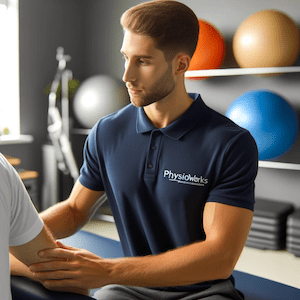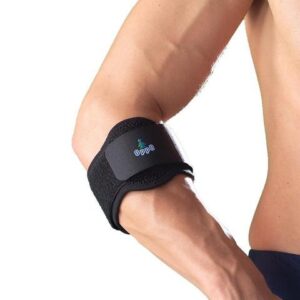Tackling Tennis Elbow
Insights from Physiotherapy and Corticosteroid Treatments
Tennis elbow, or lateral epicondylitis, is a condition that causes significant elbow discomfort and affects many individuals. This article, enriched with the latest research, aims to explore the most effective treatment options.
The Reality of Corticosteroid Injections
Recent studies, including one from the Caspian Journal of Internal Medicine, have raised questions about the long-term efficacy of corticosteroid injections for tennis elbow. While these injections offer immediate pain relief, a systematic review and network meta-analysis found that their benefits in pain reduction and functional improvement are generally short-lived, with effectiveness diminishing after the first month.

Physiotherapy: A Step Ahead
In contrast, physiotherapy, with its focus on elbow joint techniques and specific exercises, shows superior long-term results. Physiotherapy not only reduces symptom recurrence but also decreases the need for additional treatments like non-steroidal anti-inflammatory drugs, as supported by the research.
The Physiotherapy Approach
Physiotherapy takes a comprehensive approach to treat tennis elbow, focusing on several key aspects:
1. Assessment and Diagnosis
A physiotherapist begins by conducting a thorough assessment of the patient’s condition. This involves examining the range of motion of the affected elbow, strength, and any specific activities or movements that trigger pain. Through this assessment, the physiotherapist can pinpoint the exact nature and severity of the condition.
2. Individualised Treatment Plans
One of the strengths of physiotherapy is its ability to tailor treatment plans to the individual needs of the patient. Based on the assessment, the physiotherapist designs a personalised treatment plan that may include a combination of the following:
- Manual Therapy: Hands-on techniques are used to alleviate pain and improve joint mobility. These techniques may include massage, joint mobilisation, and stretching exercises.
- Exercise Prescription: Specific exercises are recommended to strengthen the forearm muscles, improve flexibility, and enhance overall joint function. These exercises are carefully selected to avoid exacerbating the condition.
- Ergonomic Guidance: The physiotherapist provides advice on proper ergonomics and techniques for activities that may have contributed to the development of tennis elbow. This includes recommendations for workspace setup and sports techniques.
3. Pain Management
Physiotherapists employ various modalities to manage pain, including ice and heat therapy, ultrasound, and electrical stimulation. These modalities can help reduce inflammation and alleviate discomfort, facilitating the healing process.
4. Education and Prevention
Patients are educated about their condition and provided with strategies to prevent its recurrence. This includes guidance on modifying activities to reduce strain on the elbow and incorporating proper warm-up and cool-down routines into physical activities.
5. Progress Monitoring
Throughout the treatment process, the physiotherapist continually monitors the patient’s progress and makes adjustments to the treatment plan as needed. This ensures that the patient is on track for a successful recovery.
The Advantages of Physiotherapy
Physiotherapy for tennis elbow offers several significant advantages:
- Long-Term Relief: Unlike corticosteroid injections, which provide temporary relief, physiotherapy aims for long-term results. By addressing the root causes of the condition and improving joint function, it reduces the risk of recurrence.
- Non-Invasive: Physiotherapy is a non-invasive and drug-free approach, making it a safe choice for individuals seeking natural and sustainable solutions to their elbow pain.
- Avoidance of Medications: Physiotherapy often reduces or eliminates the need for non-steroidal anti-inflammatory drugs (NSAIDs) or other medications, minimizing potential side effects.
- Improved Function: Through targeted exercises and manual therapy, physiotherapy not only relieves pain but also enhances the overall function of the affected elbow, allowing patients to regain their strength and mobility.
- Comprehensive Care: Physiotherapists provide holistic care, addressing not only the symptoms but also the underlying factors contributing to tennis elbow. This approach ensures a more complete and effective recovery.
In conclusion, if you’re experiencing the discomfort of tennis elbow, physiotherapy offers a proven and sustainable solution. By working closely with a skilled physiotherapist, you can regain your elbow’s health, strength, and function, allowing you to return to your daily activities with confidence and comfort. Remember, early intervention is key, so don’t hesitate to seek professional advice and embark on your journey to recovery.
The Slow Progress of the ‘Wait and See’ Approach
The ‘wait and see’ method, less immediate in impact, still showed notable progress. This approach often required supplementary treatments but exhibited lower long-term recurrence rates compared to corticosteroid injections.
Recent Research and Advancements
The study from the Caspian Journal of Internal Medicine also compared other local injection therapies like botulinum toxin (BT) and platelet-rich plasma (PRP) with corticosteroids. It found that while corticosteroids and BT provide short-term pain relief, their effectiveness in improving function and strength was not significantly better than placebo in the long term.
Comparing Treatment Outcomes
This comparative analysis highlights the need for treatments that offer sustainable benefits. Physiotherapy emerges as a more enduring solution compared to corticosteroid injections, which, despite providing rapid relief, fail to deliver lasting benefits.
Tennis Elbow Brace Effectiveness
In addition to physiotherapy and injections, another treatment modality for tennis elbow gaining attention is counterforce bracing. A significant study conducted by Martin Kroslak and colleagues, published in the Journal of Shoulder and Elbow Surgery, explored the efficacy of counterforce bracing compared to placebo bracing.
This rigorous, prospective, randomised, double-blinded, and placebo-controlled clinical trial spanned over five years, involving patients with acute tennis elbow. The findings were enlightening: both counterforce and placebo braces significantly improved pain, elbow function, grip strength, and reduced tenderness at the lateral epicondyle over six months and at a three-year follow-up.
Notably, the counterforce brace was particularly effective in reducing pain frequency and severity in the short term (2-12 weeks) and enhancing overall elbow function at 26 weeks. These results suggest that while counterforce bracing offers considerable short-term benefits in managing tennis elbow symptoms, its role in long-term recovery needs further exploration in conjunction with other treatment strategies.
More info: Tennis Elbow Braces

Understanding Tennis Elbow and Related Conditions
Recognising the interconnectedness of tennis elbow with conditions like golfer’s elbow and cervical radiculopathy is essential. An effective treatment plan should consider these related issues for a comprehensive recovery process.
What to Do? Seeking Professional Advice
If you’re experiencing elbow-related pain, consulting a physiotherapist is crucial. They can provide a tailored treatment plan, incorporating exercises and manual therapy, suited to your specific condition.
Conclusion
In summary, while corticosteroid injections and other local therapies like botulinum toxin provide temporary relief, physiotherapy stands out as the more effective, long-term treatment for tennis elbow. A combination of targeted exercises and professional guidance is recommended for sustainable management and recovery.


